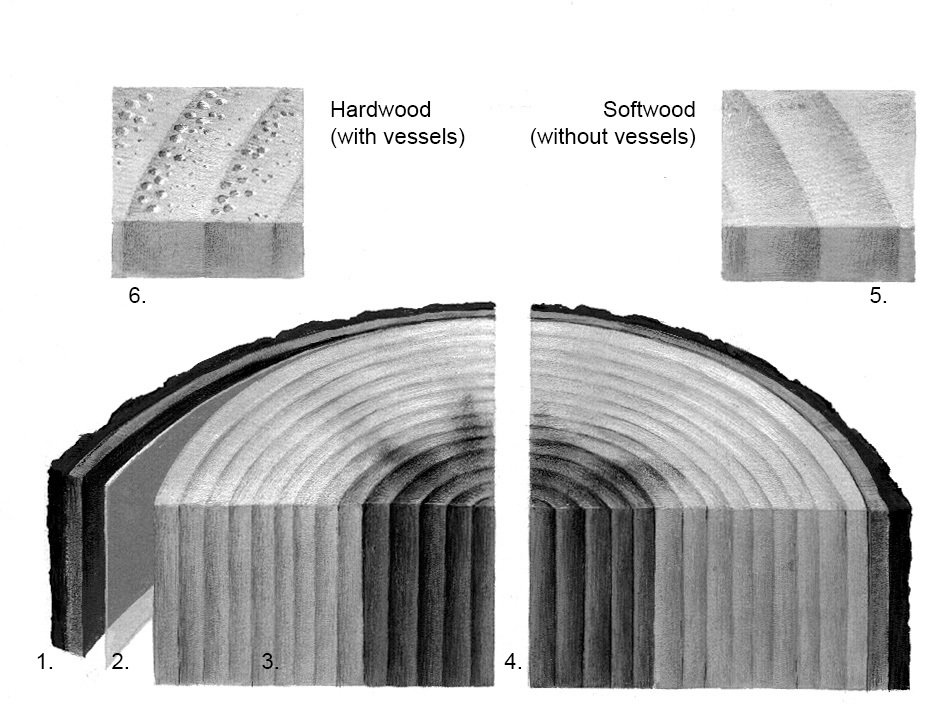Timber is in many ways a remarkable material, and an understanding of its nature is essential for those who wish to use it correctly. Under certain conditions timber is one of the most durable materials known to man. In Norway, for example, timber churches built about 1000 years ago are still in use. On the other hand, when conditions are different timber may disappear without trace in a few years, destroyed by a variety of animals or by fungus
It is a perfectly natural process that dead trees not only accumulate, but are broken down by other organisms, and it is only when we want to preserve the timber that we regard the process as injurious.
Timber is, in fact, very poor in nutrient, and there are only a few organisms which digest its principal constituents, which are lignin and cellulose. The bacteria and fungi which live on wood produce digestive enzymes which are able to break down the lignin and cellulose to substances, such as various sugars, which can be absorbed as food.
A few insects which feed on timber secrete the same kinds of digestive enzymes in their gut (this applies, for example, to the larvae of the house longhorn beetle), but the majority have a different method, for they have established an association with micro-organisms which help to break down the wood. Finally, there are some species, such as the powder post beetles, which are dependent upon the presence in the wood of starch or sugar.

The structure of timber
When a tree trunk is sawn through one can see first the outer layer or bark and then a thin growth layer. It is this layer that is responsible for the growth in thickness of the trunk or branch of a tree, for it forms bark outside and wood inside. A new growth ring is added every year. During the spring, large thin-walled cells are formed which transport water, while later in the summer the cells formed have walls that are thicker, and often darker. While the tree is growing the cells in the outermost annual rings are living and it is here that the transport of liquids from roots to leaves takes place. This part of the wood is called the sapwood, while the inner part, the heartwood, consists of dead cells. Right in the centre is the pith.
There are certain structural differences between coniferous trees, e.g. pine or spruce, and deciduous trees, such as oak or beech, and it is often difficult to distinguish these two types on external features. The surest method of distinguishing them is on the presence or absence of true vessels. These are present in deciduous trees, but absent in conifers. These vessels are specially adapted for the transport of water. In some species these are visible to the naked eye in a cross section. Oak and ash, for example, have large vessels.
In some deciduous trees, such as birch and beech, the vessels are more uniform in size throughout the season, and are generally quite small. Normally the darker colour of the heartwood is due to waste products, such as tannins, and to some extent these serve as a protection against fungal infections and the attacks of various animals. On the other hand, the heartwood is not receptive to impregnation with timber preservatives.

Animals that gnaw timber in buildings
In the forest, trees are attacked by many different kinds of animal. There are some which eat the leaves, but in the context of the present book we are more interested in those insects which attack the timber itself. Some of these attack only healthy, living trees, whereas others specialize exclusively in weakened or dead trees. Certain species live only in the growth layer immediately beneath the bark, whereas others penetrate right into the sapwood and the heartwood. Among those which attack dead trees, some species live in dry timber, and in the wild these will be found in dry branches or dead trunks which remain standing, whereas others will only thrive in damp, rotting timber.
When man began to use timber from the forest for equipment and houses certain of these insects must have entered his home. Some of them are merely transferred from the forest as eggs or larvae, and cannot live in timber that has been worked.
The species which had the most chance of survival, and which have become serious pests of timber, were those which could thrive in dry wood, for this is what is used in houses. In addition, there are several species which occur in places where timber structures have been damaged by damp and by fungus.
Identification of pests in timber
With a few exceptions it is insect larvae that attack timber, but normally these are difficult to find, and even if one does manage to extract one, it is difficult to identify with any degree of certainty.
The adult insects only appear for a short period, usually in summer, and so in most cases the culprit has to be identified from the tracks and signs it leaves in the timber. The type of tree, whether deciduous or coniferous, and its age and condition, may also provide clues.
Natural enemies of timber pests
It might be thought that animals living the greater part of their lives in timber would be well protected against enemies but this is not always the case. Wood-boring beetle larvae fall prey to many species of parasite and predator, and when an attack by such beetles is thought to have died out on its own, this is very often the work of these natural enemies.
The occurrence of such animals should, in fact, provide a warning that there are timber pests in the house.




